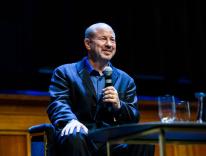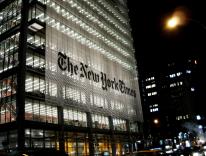I usually avoid the vice of early morning TV. I listen to the radio, which has become, by default, the generally preferred intellectual medium, providing more information per minute more densely, stripped as it is of the crutch of visual images. But, unfortunately, some visual images are the story.
On September 11, shortly after 8 a.m. in the Midwest, a sonorous male voice during NPR’s "Morning Edition" said, rather hesitantly, "It’s been reported a plane has struck the World Trade Center." I pictured many things at once, but I put down my razor and walked into the living room and turned on the television.
There it was, on the screen, Tower One burning like a cheap candle, smoke billowing upwards. It had been no small plane.
I stood watching and then saw a large jet curving toward the second tower and heard, not really hearing, since the sight was so stunning, a Fox News male voice say something like, "Here comes another one!"
It was now more than clear this was no accident. The tape of the second plane coming at the tower was run again and again. Both towers were now aflame and I said to myself that those towers would be coming down soon. It was unthinkable that the towers’ structural supports wouldn’t have been cut or damaged beyond their tolerances.
I presumed everyone would be evacuating them. Then it was reported that there was some sort of fire or explosion in Washington. There was no film of what had occurred, just the smoky aftermath. We saw uniformed personnel running across a bridge. That sight was galvanizing, because in their uniforms the event, at least, looked military.
Shortly thereafter, President George W. Bush was shown, obviously shaken, standing on a school’s stage, the backdrop’s childish decorations adding to the unease. He was in Florida, at one of his many visits to a primary school, confirming what viewers knew. Two airplanes had crashed into the World Trade Center in an apparent terrorist attack.
Then we saw the White House itself being evacuated. Some of the women removed their high heels to run more quickly. The FAA had grounded all the planes in the country. There were reports of more hijackings and of a plane crash in Pennsylvania.
Passengers using their cell phones aboard the doomed airliners were providing most of the news to the country. Amateurs and professionals are often equal in this new age of media. I heard that the first tower had collapsed; then I saw the second tower fall, a dark flower blooming in reverse, sinking back into the earth.
At the University of Notre Dame, where I teach, classes were canceled. A memorial Mass was hastily scheduled for the afternoon. Everything was, in the way our media amplifies, speeding up. The mourning had begun, even before events had sorted themselves out.
Television is a passive medium and it often points its cameras as single-mindedly as Andy Warhol did decades ago, staring mindlessly at the Empire State Building. Recently, we had been staring mindlessly at the front door of Congressman Gary Condit’s building and, in the not so distant past, at O.J.’s white Bronco, and Monica Lewinsky’s black beret. Television doesn’t invent anything; it is the great scavenger, evolutionarily equipped to absorb whatever passes by. When TV, largely thanks to cable, went to a twenty-four-hour, seven-days-a-week existence (not, strange as it seems, that many years ago), it just needed to stare longer.
News is now a nationwide cram session, all-nighters for the general public. What changes is what we are currently studying. The inclination of the nation as a whole is to take gut courses, the arts and entertainment curriculum, preferably with heavy doses of sex and death. But for the last few weeks the country has learned where the "-stans" are on the map of the world, and more about Islam and its subsets than 99 percent of us ever knew before.
Images, except for traumatic ones, are water off a duck’s back. But the planes hitting the towers (of course, more film was eventually found, more views provided) are embedded in our collective memories.
The precedent for the TV coverage of September 11 was not the Gulf War, or even Oklahoma City. It was older, more resonant, than that-the assassination of John F. Kennedy. The kamikaze hijackers have been called many things, but foremost they were assassins.
It was assassination on a scale never before seen. And the nation’s and media’s response have all the earmarks of post-assassination behavior. What was murdered was the self-image of America that we had cherished. Safe, inviolate, strong.
The attacks were over quickly and accomplished by mysterious forces, faceless men, without clear rhyme or reason. Like Lee Harvey Oswald, apocalyptic motives may be discerned, full of hatred and grandiosity. But, it is no longer the lone gunman, it is a gang. Following that trail, we have been left to investigate murky underworlds, caves in Afghanistan. That has been the media’s underlying narrative.
The Bush administration is calling it war and has begun to fight it that way, but it is not so much war as a search for killers and what created them. The two towers being struck, along with the Pentagon, had the emotional force of Kennedy being shot. The towers falling on live TV were like Jack Ruby shooting Lee Harvey Oswald on live television, a coda so final and devastating that it elevated the event even further into the realm of the fantastic and mythical. The parallels are everywhere, including the fact that the networks and cable news went commercial-free for four days, just as television broadcasting did when JFK was killed.
Kennedy’s assassination created a deep psychological shift in America. The World Trade Center/Pentagon attack is creating one even larger, but the media’s response remains the same.
Two weeks after September 11, the satirical paper The Onion produced this headline: "U.S. Vows to Defeat Whoever It Is We’re At War With."
The TV coverage these past weeks has been not necessarily cathartic, but absolutely necessary. In its headlong pursuit of images, it has given us unforgettable mental pictures. At times, they have been raw and uncensored.
And George W. Bush, like Rudy Giuliani in New York, finally recast himself as a national leader, delivering a well-crafted speech to Congress during the week after the attack, declaring a new war on terrorism unlike any other. It is clear, regardless of whatever intellectual failings Bush may have, he has learned how to read a TelePrompTer.
Now that military strikes in Afghanistan have begun, the flow of information will be severely checked. There is no reason that Bush II won’t do as well as Bush I did during the Gulf War in hobbling the press. The paradox of our oral-visual age is that, as more is made visible to a wide audience, what is kept from view becomes all the more controlled.
But television has performed a service during the first dreadful days. It has had a story as large as its appetites. Television did what it does best-it shows. And though what is merely told trails fitfully behind, more of that will catch up, in time.
Please email comments to [email protected] and join the conversation on our Facebook page.
Share
Previous Story
Death & Lies in El Salvador
Next Story
Odd man out

